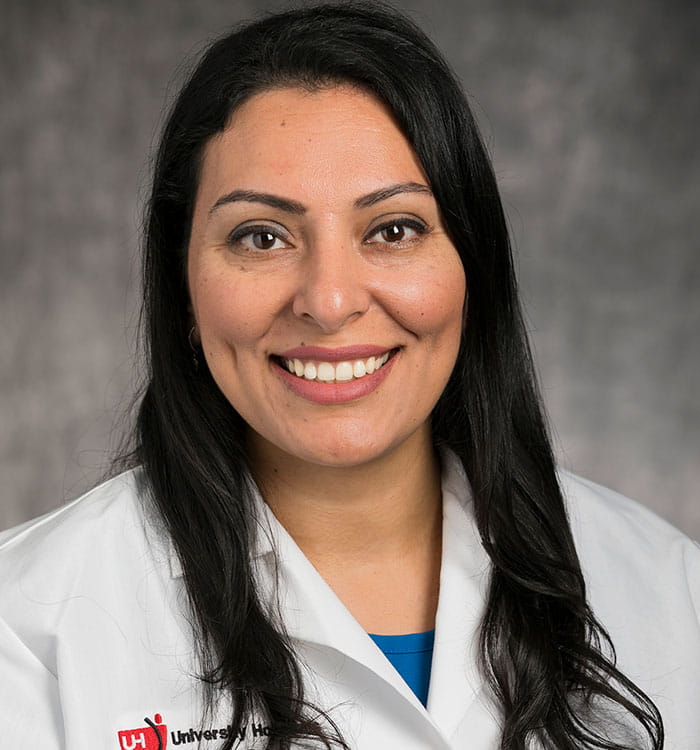Oxygen Therapy: New Option for Children and Adolescents with Down Syndrome and Obstructive Sleep Apnea?
October 11, 2022
Innovations in Pulmonology & Sleep Medicine | Fall 2022
Down Syndrome (DS) is the most prevalent chromosomal disorder, affecting approximately 6,000 live births per year, or 14 in every 10,000 births. Children with DS are at high risk for comorbidities, including dementia, cardiovascular disease and Obstructive Sleep Apnea (OSA).
 Sally Ibraham, MD
Sally Ibraham, MDThe incidence of OSA in children with Down Syndrome is about 50 to 75 percent, with some studies reporting higher numbers. First-line treatment is an adenotonsillectomy, followed by CPAP (Continuous Positive Airway Pressure).
“Sometimes children are successful with CPAP; other times they are not,” says Sally Ibrahim, MD, sleep specialist and Medical Director of the Pediatric Sleep Center at University Hospitals Rainbow Babies & Children’s Hospital. “There are a lot of barriers to using CPAP in this population, and the burden often falls on the parents, who struggle to help their children consistently use the device. We really have limited options for these children who have a high risk for residual OSA after adenotonsillectomy.”
Oxygen Therapy as a Potential Option
Dr. Ibrahim will be the principal investigator at University Hospitals Rainbow Babies & Children’s for a study that will examine the effects of oxygen therapy, which may be better tolerated than CPAP, on neurocognitive, sleep and cardiovascular outcomes.
“This is a two-armed, randomized, multi-center trial, funded by the National Institutes of Health,” she says. University Hospitals Rainbow Babies & Children’s is currently one of six centers in the United States participating in this study.
The trial will enroll about 328 children, ages 5 to 17, with residual OSA after adenotonsillectomy with an obstructive apnea hypopnea index of 5 to 40 as indicated by polysomnography (PSG). Inclusion criteria also includes children who failed CPAP and have a favorable response to oxygen therapy, which is part of the study evaluation. Children who would otherwise require 02, have significant hypoxia by PSG, or those using CPAP with appropriate adherence would not be included.
Preliminary preparations for the study began in September 2022 and the trial will begin enrolling in 2023. Dr. Ibrahim says clinicians will first determine if participants have a favorable response to oxygen therapy on a sleep study. If they don’t have adverse effects, such as retention of CO2, they will be randomized to either conservative management (weight management, positional therapy or sleep hygiene, for example) or conservative management, in addition to oxygen therapy.
“During the study, participants will periodically undergo neurocognitive testing, echocardiograms and sleep assessments to evaluate these outcomes,” says Dr. Ibrahim. “We will conduct a final sleep study and measurements at the end of the study.”
Filling in the Gaps, Helping Patients
Dr. Ibrahim says that beyond genetic processes that drive dementia in DS, clinicians do not know how comorbidities such as OSA play a role in long-term neurocognitive outcomes in these patients. Intermittent hypoxia from OSA may lead to oxidative stress and neuroinflammation. However, she says, based on studies in dementia and brain function with long-term sleep problems, they speculate that sleep may play a role in the long-term outcomes of DS patients.
This new study will look at neurocognitive and cardiovascular outcomes when using oxygen therapy to treat OSA in children with DS. This study will also hopefully shed light for future studies.
“There are a lot of DS children with untreated OSA,” says Dr. Ibrahim. “We don’t always have options beyond CPAP and post adenotonsillectomy, so this study provides an opportunity to investigate a treatment that will help guide our clinical management of these patients. We hope that pulmonologists and other clinicians who treat DS patients will consider enrolling them in this study, regardless of where they receive their primary care. UH Rainbow Babies & Children’s is well positioned to provide both primary and specialty care for children with DS and will work across institutions to improve outcomes for this population. This is also an opportunity to raise awareness and for families to receive additional information about sleep apnea.”
For more information about this trial or OSA in children with DS, call Dr. Ibrahim at 216-844-1750.
Contributing Expert:
Sally Ibrahim, MD
Director, Pediatric Sleep Center
UH Rainbow Babies & Children's Hospital
Assistant Professor
Case Western Reserve University School of Medicine


